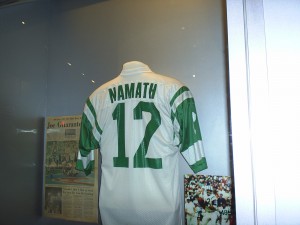Pro Football HOF Super Bowl III Display
The Games That Changed The Game is the title of a book written by Ron Jaworski, chronicling games over the years in which creative, innovative coaches like Sid Gillman and Bill Walsh introduced wrinkles that changed the way the game was played. I haven’t read the book so I don’t know which specific games Jaworski mentions, but without a doubt Super Bowl III was a game that definitely changed the landscape of the entire sport. The third NFL-AFL World Championship game, which was the first to actually be called the “Super Bowl”, didn’t have any amazing strategic developments that drastically changed the way the sport was played, although the methodical way Joe Namath and the New York Jets’ offense attacked the vaunted Baltimore Colts’ defense was pretty amazing. Most sports fans know the general storyline of the game. The Jets, representing the young, upstart American Football League, entered the game against the Colts as 18-20 point underdogs. The NFL’s Green Bay Packers had won the first 2 title games between the leagues, dispatching Kansas City and Oakland in games that were mostly one-sided. In this matchup, the Colts were considered a juggernaut, coached by young genius Don Shula, with an overpowering defense, generally thought to be even better than Vince Lombardi’s Packer teams. At the same time, the Jets were a long shot to even get through the playoffs in their own league, and even though they advanced to the Super Bowl, were not considered the overall best team in the AFL. According to all the football experts at the time, this game was going to be a monumental blowout. Shockingly, at a pre-game event at the Miami Touchdown Club (the game was played at the Orange Bowl), Namath, in response to a heckling Colt supporter, boldly proclaimed,”We’re gonna win the game. I guarantee it.” He then went out and backed up his words, engineering a conservative, ball-control game plan that resulted in a 16-7 win for the Jets, and for the entire AFL. Namath, in the 1968 regular season leading up to this game, didn’t have a spectacular year, throwing only 15 touchdown passes compared to 17 interceptions, with only a 49% completion percentage. Also, he didn’t have an outstanding statistical passing day in the Super Bowl. He mostly did what modern day coaches would call “manage the game”, beating the Colts’ blitzing defense with quick, short passes to his backs and tight end to keep drives alive. The Jets scored only one touchdown, on a short run by Matt Snell, and amazingly, Namath didn’t complete a pass in the fourth quarter of the game.
At the time of the game, nobody, except for the Jets themselves, believed the mighty Colts could lose. After they blew out the Cleveland Browns 34-0 in the NFL championship game, they were being touted as “the greatest team in pro football history”. Looking back now, it was a classic case of a team being over-hyped. The Colts’ roster was actually full of aging players near the end of their careers – like Earl Morrall, Tom Matte, Jimmy Orr, Bobby Boyd and Lou Michaels. Their 34-0 thrashing of the Browns was revenge for the 27-0 pasting the Browns had put on the Colts in the 1964 title game, but that was misleading. By 1968, Jim Brown had moved onto an acting career, and QB Frank Ryan had been replaced by journeyman Bill Nelsen. The Browns were in the beginning stages of a downward fall, and that hammering by the Colts in the title game made the Colts look more dominating than they really were. The Colts’ defense overwhelmed the NFL that year using a blitzing zone scheme that confused the rest of the teams in the league. What was overlooked prior to the Super Bowl was the fact that the Jets faced a lot of zone defenses in the AFL, and were well-equipped and confident that they could beat the Colts’ defense. The result of the game was a shocking Jets’ victory that changed the perception of the AFL as a second tier league. In the early 1960s some NFL owners laughed them off as a “Mickey Mouse” league, but this game established the AFL as equals to the older league, and a year later the Kansas City Chiefs added an exclamation point by upsetting the heavily favored Minnesota Vikings in Super Bowl IV. Again, the pundits overlooked the fact that the Vikings were led by an old recycled QB from the Canadian League, Joe Kapp, and had a roster peppered with aging players like Mick Tinglehoff, Karl Kassulke, Roy Winston and Bill Brown. At the same time, the Chiefs were led by dynamic young players like Mike Garrett, Otis Taylor, Willie Lanier and Buck Buchanan. The problem was the AFL was very much underpublicized at the time compared to the older NFL. That changed completely going into the 1970s.

Cleveland
February 4, 2011 at 2:37 pm
Many thanks for finding the time to explain the terminlogy to the starters!